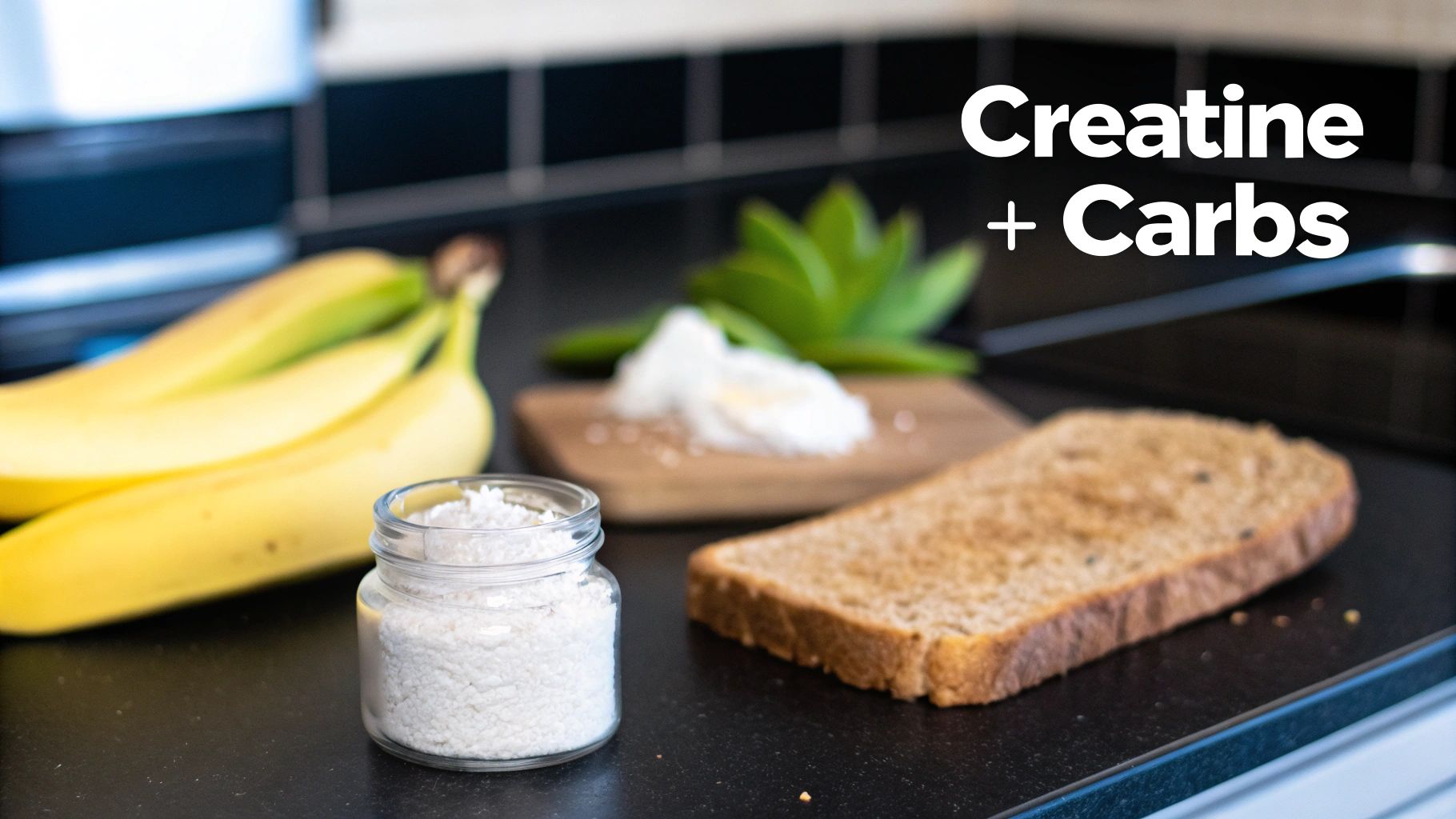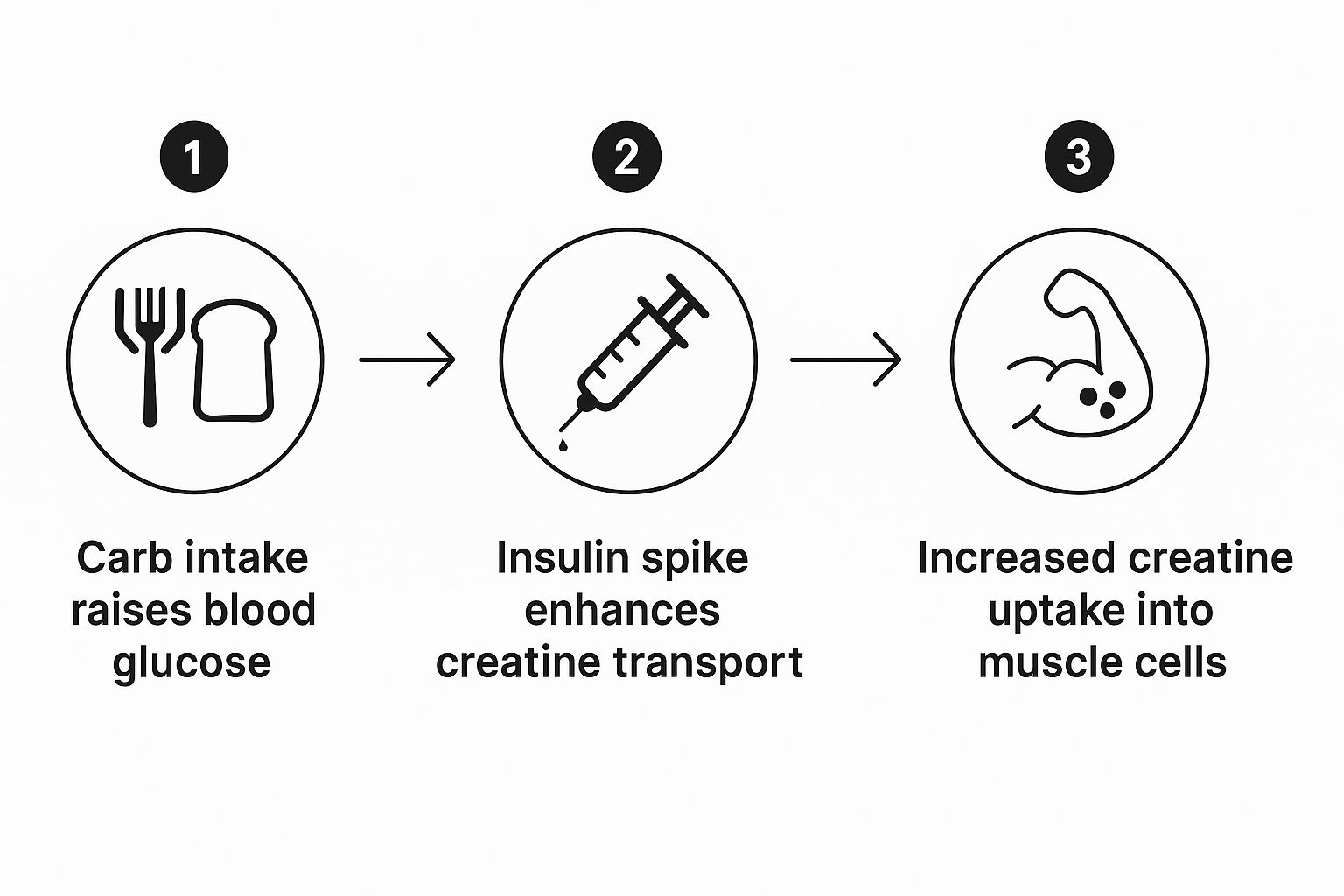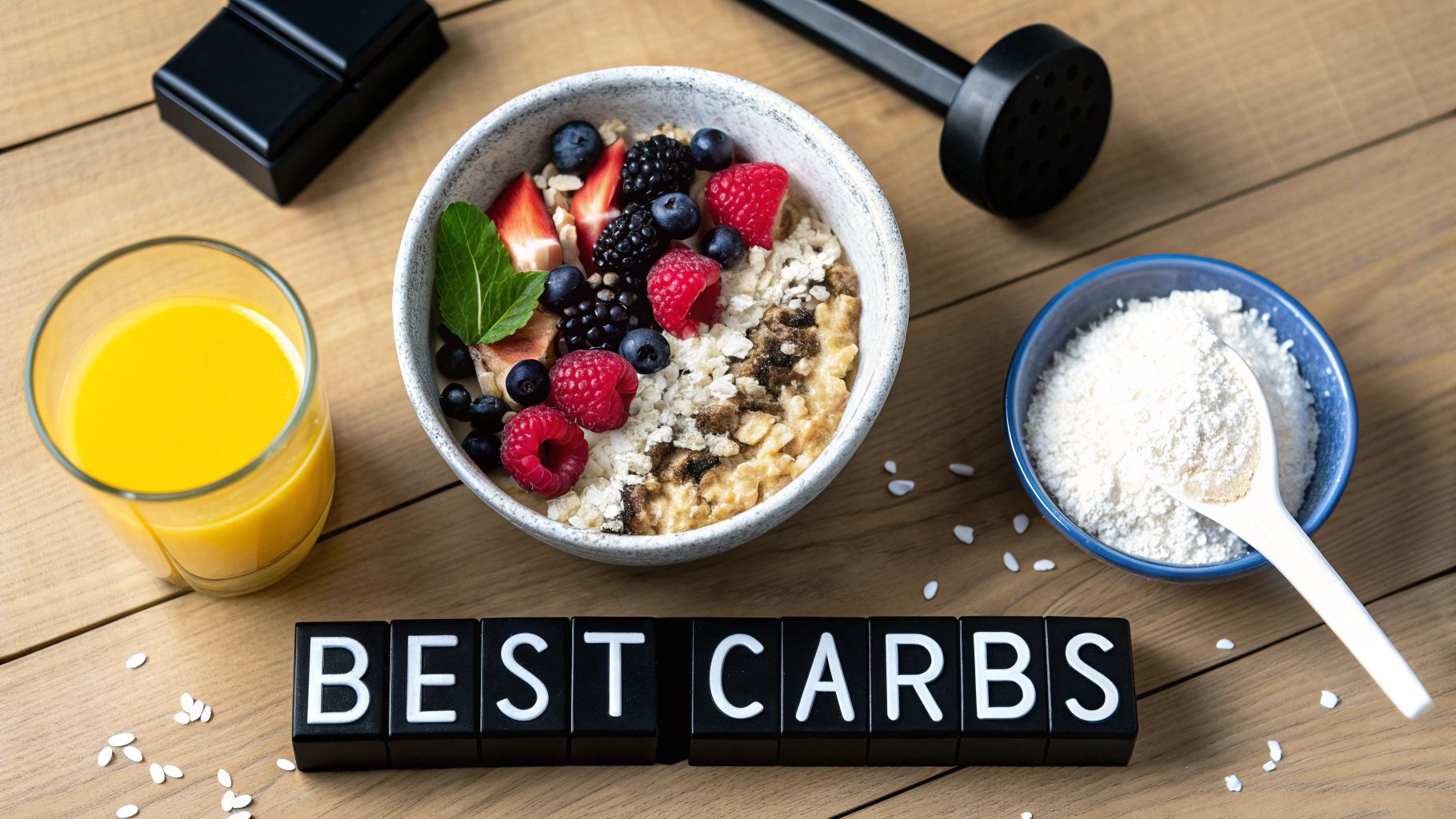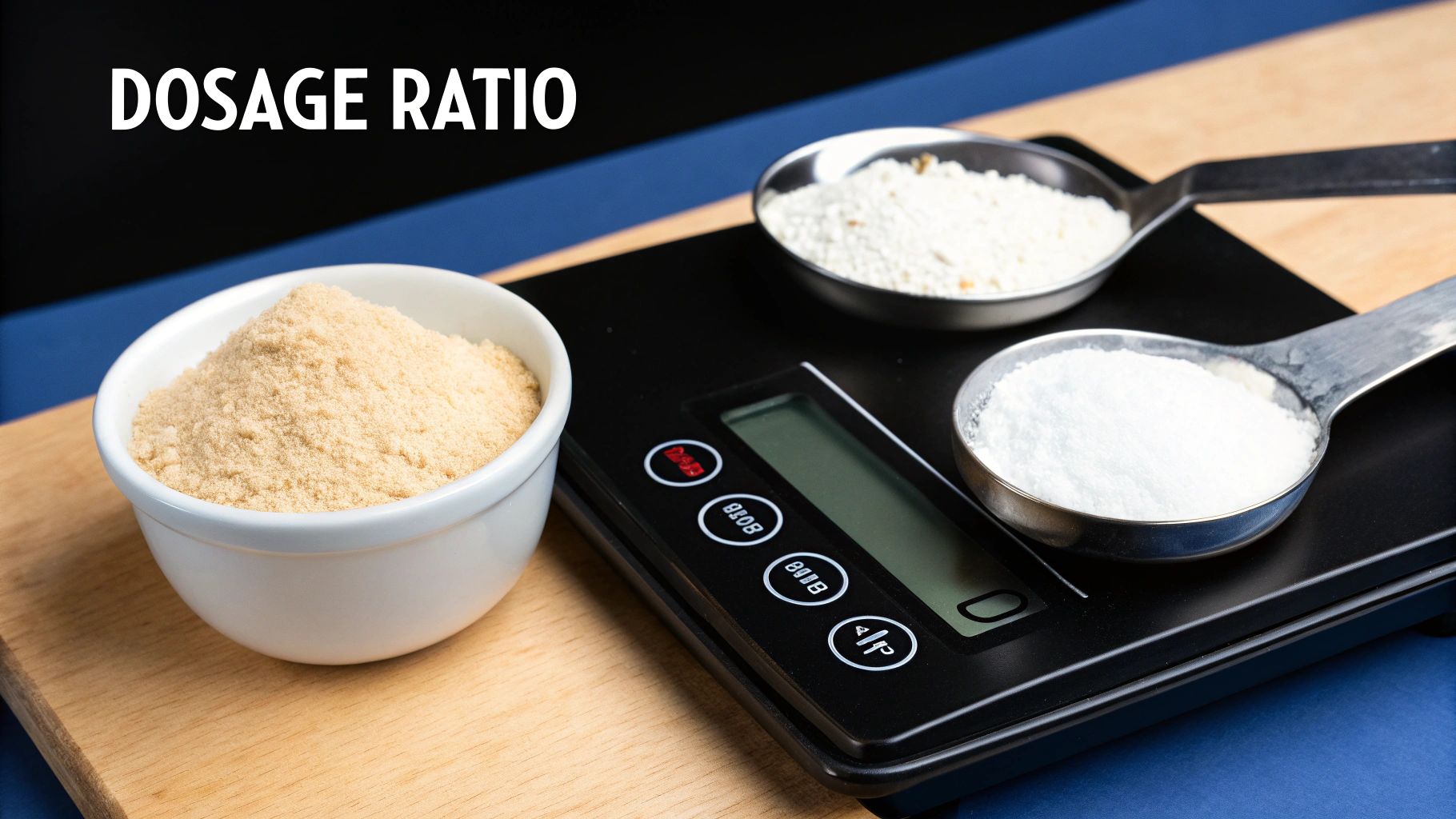
Creatine With Carbs Your Ultimate Guide to Muscle Growth
Share
Taking creatine with carbs is a well-established strategy to get the most out of your supplement. While creatine is powerful on its own, adding carbohydrates is like giving it a turbo-boost, helping it get into your muscle cells where it can actually do its job.
It’s the difference between standard shipping and express delivery for your muscles.
Why Pairing Creatine With Carbs is a Game Changer

Creatine is one of the most studied and effective supplements for boosting strength and muscle growth. But for it to work, it has to get from your gut into your muscle tissue. That’s not a given.
This is where carbohydrates come into play, acting as the key that unlocks the door to your muscles.
The Insulin Spike Advantage
When you eat carbs—especially simple, fast-digesting ones—your body releases a powerful hormone called insulin. Most people know insulin for managing blood sugar, but it's also a master transport hormone.
Think of insulin as a doorman for your muscle cells. It opens them up to let nutrients in, not just glucose, but amino acids and, you guessed it, creatine. So, when you take creatine with carbs, the resulting insulin spike acts like a supercharged delivery service.
This isn't just bro-science; it's grounded in solid research. One of the landmark studies in this area showed that taking 5 grams of creatine with about 93 grams of simple carbs increased total muscle creatine by a whopping 60% more than taking creatine alone. If you're interested in the specifics, you can dig into the original creatine and carb research and see its impact on sports nutrition.
Key Takeaway: The insulin spike from carbohydrates dramatically enhances the transport of creatine into your muscles. More creatine in the muscle means better performance and faster results.
To give you a clearer picture, let's break down the difference between taking creatine by itself versus with a strategic carb source.
Creatine and Carb Synergy At A Glance
| Supplement Strategy | Muscle Absorption Rate | Primary Mechanism | Best For |
|---|---|---|---|
| Creatine Alone | Slower, less efficient | Passive transport | Maintenance, low-carb diets, convenience |
| Creatine with Carbs | Faster, significantly enhanced | Insulin-mediated transport | Loading phases, maximizing uptake, post-workout |
As you can see, simply adding a source of carbohydrates ensures you're not just taking creatine, but that you're absorbing it for maximum effect. This synergy helps saturate your muscles more quickly, translating to faster gains in strength, power, and size. You're getting more bang for your buck from every single scoop.
How Insulin Supercharges Creatine Absorption
To get why taking creatine with carbs is a game-changer, we need to talk about one powerful hormone: insulin. Most people think of insulin in terms of blood sugar, but it's really a master transport hormone—think of it as a super-efficient delivery driver for your body.
When you eat carbs, especially the simple, fast-digesting kind, your blood glucose levels go up. This is the signal for your pancreas to release insulin. From there, insulin travels to your muscle cells and basically knocks on their door, telling them to open up and let the nutrients in.
The Creatine Transporter Connection
Your muscle cells have dedicated gateways just for creatine, called creatine transporters (CreaT). You can picture these as VIP entrances. The key is that the presence of insulin dramatically ramps up the activity of these transporters.
It’s like getting into an exclusive club. On its own, the line to get creatine into the muscle is pretty slow. But when insulin arrives, it's the A-list celebrity that tells the bouncer to open the velvet ropes and usher everyone inside, fast. Creatine gets a priority pass, moving from your bloodstream right into your muscle tissue much more effectively than it would otherwise.
The Insulin Effect: Higher insulin levels directly lead to more active creatine transporters on the surface of your muscle cells. The result is a major increase in creatine uptake.
This simple biological mechanism is exactly why that post-workout shake with carbs helps your creatine supplement work so much harder for you.
This infographic breaks down the simple, three-step process of how insulin helps get creatine where it needs to go.

As you can see, the sequence is straightforward. Eating carbs leads to an insulin spike, which then fires up the transport system for better muscle absorption.
Maximizing the Anabolic Window
This insulin-powered delivery system is at its peak during the post-workout period, which many people call the "anabolic window." After a tough workout, your muscles are starving for energy—their glycogen stores are low, and they've become incredibly sensitive to insulin.
This heightened sensitivity means your muscles are primed to soak up nutrients like glucose and creatine to kick off the repair and growth process. By taking your creatine with some fast-acting carbs during this window, you ensure your muscles get exactly what they need, right when they're most receptive.
Of course, this strategy is all about maximizing nutrient delivery. If you're using a different eating schedule, like intermittent fasting, you might be asking yourself, "does creatine break a fast?" That's a whole different set of considerations.
By strategically pairing creatine and carbs, you're doing more than just taking a supplement. You're creating the perfect physiological environment to shuttle creatine directly where it needs to be for real results.
Perfecting Your Timing for Maximum Gains

You already know that pairing creatine with carbs is a game-changer. But when you take this combo can be the difference between good results and great results. Timing really is a critical piece of the puzzle.
While taking creatine at any point in the day will still provide benefits—consistency is king, after all—the period right after your workout is a golden opportunity. This is what athletes and bodybuilders call the "anabolic window," a time when your muscles are practically starving for nutrients.
The Power of the Post-Workout Window
Think of your muscles after a tough workout like a dry sponge. They’ve just been pushed to their limits, their fuel tanks (glycogen) are running low, and they've become incredibly sensitive to insulin.
This heightened insulin sensitivity is your secret weapon. When you down a mix of fast-acting carbs and creatine during this window, you're essentially giving your body exactly what it needs, right when it can use it most effectively. The insulin spike from the carbs acts like an express delivery service, rushing that creatine straight into your muscle cells.
The sweet spot is to get your creatine and carb mix in within 30 to 60 minutes after you finish your training. This strategy hits that peak insulin sensitivity, driving maximum creatine into your muscles and kicking off the glycogen refueling process.
If you're looking to get even more granular with your supplement schedule, our guide on when to take creatine for best results breaks it all down even further.
Pre-Workout vs. Post-Workout Timing
The post-workout window is widely considered ideal, but what about taking creatine before you train? It’s a popular approach, but the science actually gives the edge to post-workout for maximizing muscle growth and strength.
Let's break down the two strategies:
- Pre-Workout: The thinking here is to flood your muscles with creatine just before you need the extra power. It’s not a bad idea, but research suggests it’s slightly less effective for building long-term lean mass when compared to taking it after.
- Post-Workout: This approach works with your body's natural recovery cycle. Studies comparing the two have found that athletes who took creatine after training gained more lean body mass and saw better strength improvements than those who took it before their workouts.
At the end of the day, just taking creatine consistently is what matters most. But if you're chasing every possible advantage, the evidence points toward a post-workout protocol. This simple shift ensures your creatine and carbs arrive precisely when your muscles are primed for repair and growth, helping you squeeze every ounce of progress from your hard work.
Choosing the Right Carbs to Pair With Creatine
So, you know you need carbs with your creatine. But does that mean you can just grab a slice of whole-wheat toast and call it a day? Not exactly.
To really kickstart that creatine delivery system, you need to be selective. We're looking for carbs that digest quickly and send your blood sugar on a rapid upward trajectory. This is where the glycemic index (GI) comes into play.
Think of the GI as a speed rating for carbs. High-GI foods are the sprinters—they break down fast, flooding your bloodstream with glucose and triggering a powerful insulin spike. This is precisely what you want to act as an express shuttle for getting creatine into your muscles.
Fast-Digesting Carbs Are Your Best Bet
Slow-burn, high-fiber carbs like oatmeal or brown rice are fantastic for providing steady energy throughout the day. But after a workout, they're just too slow for our purposes. They don't create that immediate insulin rush needed to maximize creatine absorption.
For your post-workout window, you want simple, fast-acting sugars.
Here are some of the most effective partners for your creatine:
- Dextrose or Maltodextrin: These are simple carb powders designed for one thing: speed. They mix easily into any shake and are probably the most direct and affordable route to a fast insulin spike.
- Fruit Juice: A glass of grape or orange juice is a classic for a reason. It's loaded with simple sugars like fructose and glucose that get the job done quickly.
- Ripe Bananas: A banana that's gone from green to yellow with a few brown spots is a perfect whole-food option. As it ripens, its starches convert into simple sugars, raising its GI and making it ideal for post-workout.
- White Rice or Potatoes: They might not taste sweet, but the starches in these foods are rapidly broken down into glucose by your body, making them surprisingly effective.
The game plan is simple: Spike your insulin with fast-acting carbs. This insulin surge acts like a key, unlocking your muscle cells to allow creatine to flood in.
Consistently hitting your macros can be tricky. Using one of the best food tracking apps is a great way to make sure you're getting the right amount of carbs with your creatine every time.
Choosing the right carb source often comes down to what's convenient and works for you. Here’s a quick breakdown of some top options.
Top Carbohydrate Sources for Creatine Transport
This table ranks common carbohydrate sources by their Glycemic Index (GI), giving you a clear guide for what to reach for after your workout.
| Carbohydrate Source | Glycemic Index (GI) | Typical Serving Size | Best Use Case |
|---|---|---|---|
| Dextrose Powder | 100 | 30-50g | Mixed directly into a post-workout shake. |
| Maltodextrin | 95-105 | 30-50g | Ideal for shakes; often in mass gainers. |
| White Rice | 73 | 1 cup, cooked | As part of a post-workout meal. |
| White Potato | 78 | 1 medium | A great whole-food meal option. |
| Grape Juice | ~50-60 | 8 oz (240ml) | A quick, convenient liquid option. |
| Ripe Banana | ~51 | 1 large | Perfect for blending into a smoothie. |
Ultimately, whether you grab a specialized powder or just a glass of juice, the science is the same. By pairing creatine with a high-GI carb, you're not just taking a supplement; you're actively optimizing its journey to your muscles for better growth and recovery.
Optimizing Your Creatine Loading Phase

If you want to see what creatine can do for you—and you want to see it fast—a "loading phase" is the way to go. Think of it as an express lane to fully stocking your muscles with creatine. Instead of taking weeks to slowly build up your levels, the loading phase gets the job done in just a few days.
The classic protocol is straightforward: you'll take about 20 grams of creatine per day for five to seven days. To make it manageable, you split this into four smaller 5-gram servings throughout the day. This is the strategy that rapidly boosts intramuscular creatine and has made the supplement a staple for millions. To give you an idea of its popularity, athletes in the U.S. alone go through over four million kilograms of creatine every year, and many of them kick things off with a loading phase. You can dig deeper into creatine's widespread use in sports nutrition on pmc.ncbi.nlm.nih.gov.
Supercharging Your Load With Carbs
Now, here's how to make that loading phase work even better. Remember the insulin-shuttling trick we talked about? By pairing each of those 5-gram creatine doses with fast-acting carbs, you're essentially giving every dose a VIP escort directly into your muscle cells. The insulin spike from the carbs ensures that more of the creatine gets stored and less goes to waste.
Here’s what a loading day could look like in practice:
- Morning Dose: 5g of creatine mixed into a glass of orange or grape juice.
- Lunchtime Dose: 5g of creatine blended into a fruit smoothie.
- Pre-Workout Dose: 5g of creatine with a sports drink or carb powder.
- Post-Workout Dose: 5g of creatine in your recovery shake along with carbs and protein.
Spreading out your intake and combining creatine with carbs each time is a double win. You maximize absorption while also avoiding the potential for an upset stomach that can sometimes happen with a single large dose.
Key Insight: A loading phase is an optional but powerful strategy to fast-track muscle creatine saturation. Adding carbs to each dose during this phase makes the process significantly more efficient.
The Slow and Steady Approach
A loading phase is effective, but it's not for everyone, and it's definitely not mandatory. If you prefer a simpler method, you can skip the loading entirely and just start with a maintenance dose. This means taking a single, smaller amount—typically 3-5 grams per day—right from the beginning.
This slow-and-steady approach will get your muscles to the same saturation point. It just takes a bit longer, usually around three to four weeks. If you aren't in a hurry or find that higher doses don't agree with you, this method is a fantastic alternative. To dial in your specific number, you can learn how to calculate your perfect creatine dosage. It's a simpler routine that delivers the exact same results in the long run.
Making Sense of the Modern Creatine Aisle
The science we've been talking about—combining creatine with carbs—didn't just stay tucked away in research papers. It completely reshaped the supplement aisle you walk down today. If you've ever felt overwhelmed by the sheer number of options, understanding this science is the key to decoding what's on the shelf.
The supplement industry is always looking for the next big thing, and when the research on creatine and insulin synergy came out, they saw a massive opportunity. And they ran with it.
The Boom of "All-in-One" Post-Workout Shakes
This new understanding sparked the creation of countless all-in-one post-workout formulas. Suddenly, you didn't need to play chemist, mixing separate tubs of creatine, dextrose, and protein. Brands started doing the work for you, creating convenient products that packed everything your muscles were screaming for into a single, simple scoop.
These enhanced formulas are engineered to be the ultimate recovery shortcut. By putting creatine, fast-acting carbs, and usually a high-quality protein like whey all in one place, they create the ideal storm for muscle repair and growth. The carbs spike your insulin, which then acts like a key, unlocking your muscle cells to shuttle in both the creatine and the amino acids from the protein.
This combination of convenience and proven effectiveness has been a huge driver in the market. As more people get serious about fitness, they look for scientifically-sound products that are easy to use and actually work. The global market for creatine supplements, currently valued at around USD 515.2 million, proves just how strong this demand is. In fact, North America makes up over 40% of that total revenue.
You can dive deeper into the numbers by checking out this creatine market analysis on cognitivemarketresearch.com, but the trend is clear: this market is growing, fast.
The Bottom Line: The products crowding the shelves aren't just a jumble of ingredients. They are the direct result of research showing that creatine, when paired with something that spikes insulin, works far better than taking creatine all by itself.
So, the next time you're looking at a post-workout blend that lists creatine with carbs, you'll know exactly what the formulators were thinking. It's not marketing fluff; it's a product built on a solid foundation of performance science, designed to make every bit of your recovery count.
Common Questions About Creatine and Carbs
Even when you get the science, putting it into practice can bring up a few questions. Let's tackle some of the most common things people ask about pairing creatine with carbs so you can feel confident in your approach.
Do I Absolutely Need Carbs for Creatine to Work?
Nope, you don't. Creatine works perfectly fine on its own. Your muscles will eventually get saturated with it, with or without carbs. The real difference is speed and efficiency.
Adding carbs creates an insulin spike that basically gives creatine an express pass into your muscle cells. Think of it like this: creatine can take the local bus to get to your muscles, and it'll get there eventually. But when you add carbs, you’re putting it on a high-speed train. It gets there faster and more of it arrives, which can translate to seeing results a bit sooner.
How Many Grams of Carbs Should I Take?
To get that strong insulin response we're looking for, studies suggest aiming for 50 to 100 grams of fast-acting carbs along with your standard 5-gram dose of creatine.
But don't overcomplicate it. A super practical way to hit this number is to just mix your creatine into your post-workout shake. If your shake already has a good mix of nutrients—say, a 2:1 or 3:1 carb-to-protein ratio (like 60g of carbs and 30g of protein)—you're golden.
Pro Tip: This combo is a powerhouse. It doesn't just drive creatine into your muscles; it also jumpstarts glycogen replenishment and protein synthesis, creating the ideal environment for recovery and growth.
Can I Just Use Fruit Juice Instead of a Carb Powder?
You bet. Fruit juice is a fantastic real-food option. Things like grape juice or orange juice are loaded with simple sugars that your body absorbs quickly, giving you that necessary insulin spike to help shuttle creatine into your muscles.
Just make sure you drink enough. You'll want a serving that provides around 50-70 grams of carbohydrates, which usually means about 16-24 ounces of juice. It's a simple, and honestly pretty tasty, way to get the job done.
Will Taking Carbs With Creatine Make Me Gain Fat?
That's a valid concern, but if you time it right, it's highly unlikely. The magic window is right after your workout.
At that point, your muscles are like sponges, completely depleted and desperate to soak up glucose to refill their energy stores (glycogen). They’ll use those carbs for recovery, not for fat storage. As long as these post-workout carbs fit into your overall daily calorie goals, they’ll be put to good use building muscle, not adding fat.
Ready to make your creatine routine simpler and tastier? The delicious creatine gummies from Smash.com deliver your full 5-gram dose without any messy powders or shaker bottles, making it easy to stay consistent and smash your goals. Find your favorite flavor at https://smash.com.